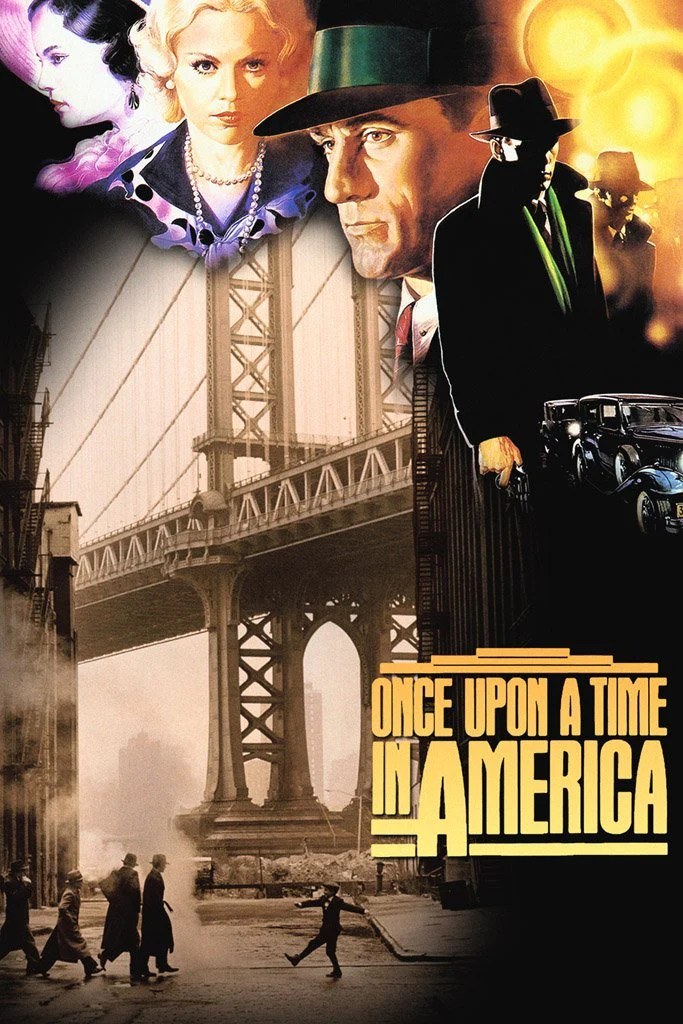Once Upon a Time in America (1984)

“Once Upon a Time in America,” directed by the legendary Sergio Leone, is a monumental film that explores themes of friendship, betrayal, and the American Dream through the eyes of Jewish gangsters in early 20th-century New York City. Released in 1984, this crime drama stands as a testament to Leone’s masterful storytelling and cinematic vision, captivating audiences with its rich narrative and stunning visuals.
Plot Overview
The film chronicles the life of David “Noodles” Aaronson (played by Robert De Niro) and his friends as they navigate the treacherous world of organized crime from their childhood in the 1920s to their adulthood in the 1960s. The narrative unfolds non-linearly, oscillating between Noodles’ nostalgic memories of his youth and the harsh realities of his present life, creating a profound sense of melancholy and reflection.
Noodles, along with his childhood friends Max Bercovicz (James Woods), and others, rise through the ranks of the criminal underworld, engaging in bootlegging, robbery, and murder. Their bond is tested as ambition and power play a crucial role in their relationships, ultimately leading to betrayal and heartbreak.
Cinematic Mastery
Sergio Leone’s direction is nothing short of extraordinary. The film is marked by long, sweeping shots that immerse viewers in the era’s atmosphere, combined with an evocative score composed by Ennio Morricone. The haunting melodies perfectly complement the film’s emotional depth, reinforcing the themes of nostalgia and loss.
The cinematography captures the grit and glamour of the time, portraying both the vibrant nightlife and the harsh realities of the streets. The meticulous attention to detail in set design and costumes transports the audience to a bygone era, making every scene visually arresting.

Themes and Legacy
“Once Upon a Time in America” delves into the complexities of friendship, loyalty, and the moral ambiguities of the criminal world. It raises questions about the price of success and the inevitable consequences of betrayal. The film’s portrayal of the American Dream is both aspirational and cautionary, illustrating how the pursuit of wealth and power can lead to moral decay and personal tragedy.
Though initially met with mixed reviews and commercial struggles upon its release, the film has since gained critical acclaim and is regarded as one of the greatest gangster films of all time. Its influence can be seen in numerous subsequent films that explore similar themes of crime and loyalty.
Conclusion
“Once Upon a Time in America” is not just a film about gangsters; it’s a poignant exploration of human relationships set against the backdrop of ambition and betrayal. Sergio Leone’s masterful storytelling and Robert De Niro’s compelling performance make this epic a must-watch for any film enthusiast. As the story unfolds, viewers are left to ponder the fleeting nature of time and the indelible marks left by our choices. This film is a timeless classic that continues to resonate with audiences, ensuring its place in cinematic history.
Whether you’re revisiting this masterpiece or experiencing it for the first time, “Once Upon a Time in America” promises to leave an indelible impression, inviting you to reflect on the intricacies of life, friendship, and the pursuit of dreams in a world rife with challenges.
Suggested videos for you:











